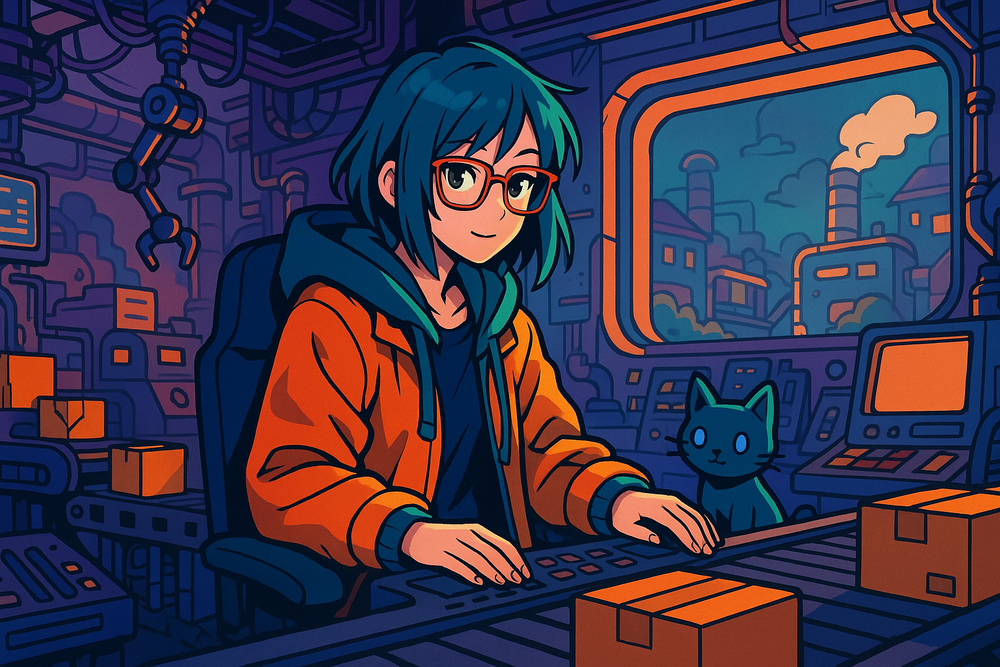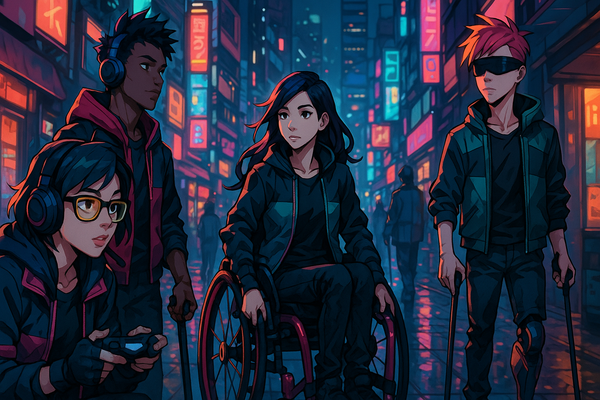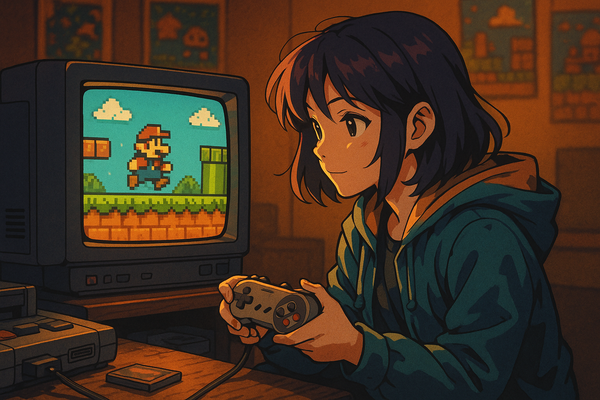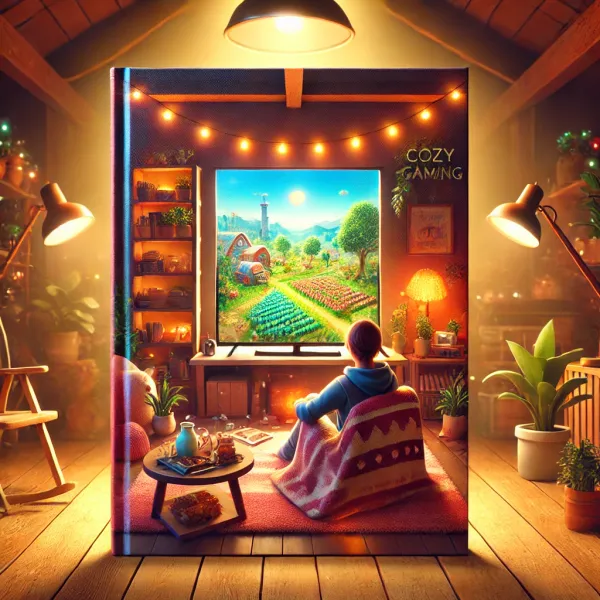The rise of cozy automation: Merging chill games with factory sims
From iron and oil to pastel and peace
Early factory-building games like Factorio and Satisfactory captivated players with their complexity and scale. These games dropped us onto hostile alien worlds and tasked us with mastering industry at any cost. In Factorio, you “build and maintain factories” on a barren planet, ruthlessly mining resources, automating production, and even fending off alien creatures drawn by your pollution (factorio.com). Satisfactory likewise presents a “first-person open-world factory building” adventure that lets you “conquer nature” on a lush alien frontier, exploiting its resources and confronting wildlife as needed (satisfactorygame.com). The aesthetic of these pioneers was often harsh and utilitarian – assembly lines snaking over rust-colored plains, smokestacks chugging under an alien sun. Efficiency and expansion were the goals, sometimes at the expense of gentleness.
But even as these industrial epics thrived, a quieter revolution was brewing on the fringes of gaming. Developers began to ask: What if the thrill of automation and resource management could be made… cozy? Could the clanking factories and fierce aliens soften into something more nurturing and calm? Around the late 2010s and early 2020s, the first answers to that question emerged. Games like Autonauts hinted at a hybrid approach – Factorio-like automation wrapped in a warm, playful aesthetic. In Autonauts, you land on a virgin world not to strip-mine it aggressively, but to “build a thriving civilization” at your own pace, aided by an army of charming little robots (pcgamer.com). A reviewer noted that Autonauts is “playful, welcoming and charming,” even comparable to the cute farming sim Stardew Valley in vibe (theguardian.com). Automation was still the key to progress, but it felt empowering in a quiet way – a far cry from the anxiety of fighting off alien hordes. The genre’s sharp edges were beginning to soften.
The emergence of “Cozy” automation
By the mid-2020s, this fusion of factory sims with cozy game design has blossomed into a bona fide trend. The transformation didn’t happen in a vacuum. It’s part of the broader “cozy games” movement that exploded during the COVID-19 pandemic and never looked back. As people sought comfort and escape, non-violent, low-pressure titles gained immense popularity. Google searches for “cozy games” peaked well after 2020, and even big studios took notice (theverge.com). Steam now hosts a “cozy” tag that saw 373 games released under it in 2024 alone – more than one new cozy title per day. These games share core values identified by designers as “safety, abundance, and softness.” There’s no looming threat, nothing lacking or urgent, and a soft aesthetic that “wraps everything up like a warm hug”. Initially, cozy gaming was exemplified by farming sims, home designers, and life simulators. Now, intriguingly, it’s infiltrating the factory-building genre – traditionally one of gaming’s more stressful sandboxes – and turning it into something comforting.
Cozy automation games blend the soothing loops of farming/life sims with the logistical depth of resource management. They invite players to engage with the same addictive “just one more task” flow of a factory sim, but without the chaos or pressure. There’s a poetry to this merger: the clatter of conveyor belts is tuned down to a gentle hum; the neon warning lights are recolored in pastels. Instead of a dire race against time or attacks, these games encourage open-ended tinkering and creative optimization at your own pace. One critic describing Nova Lands – an island automation adventure – called it “a promising, lower-key take on the automation game,” focused on guiding cute logistic bots rather than juggling complex belt networks (pcgamer.com). In other words, the spirit of a factory sim is there, but mellowed and made accessible to a broader, perhaps more relaxation-seeking audience.
The vibrant outback charm of Dinkum exemplifies the new wave’s gentle aesthetic – a “wonderfully unique… colour palette” of sun-baked soil and breezy wildflowers, far removed from the grim factory floors of yore (gameshub.com). Instead of sterile machines, you build cozy towns inspired by the Australian countryside, complete with wombat ranching and friendly neighbors.
Crucially, these games draw as much from Animal Crossing and Stardew Valley as from Factorio. Many feature day-night cycles, villagers or creatures to care for, and light narratives on top of their crafting and building. For example, Spirittea puts you in charge of a rustic bathhouse for wayward spirits – Stardew Valley’s easygoing daily routine crossed with the magical charm of Spirited Away (gamesradar.com). You’ll manage resources and upgrades, yes, but you’ll also feed the cat spirit and solve local mysteries in a leisurely “one more day” rhythm. My Time at Sandrock, a life-sim/crafting RPG from China, goes a step further in blending cozy life simulation with production systems. As a builder restoring a desert town, you erect machines and assemble complex materials, yet the experience remains story-driven and friendly. One review noted that Sandrock “pairs genuine resource scarcity” – a nod to classic survival management – with the fulfilling goal of rebuilding a community, all in a wholesome, character-rich package (store.steampowered.com). Around the world, developers from Australia to Brazil to China are exploring this middle ground. It’s a global trend, reflecting universal player desires for comfort without sacrificing creativity.
Pastel palettes and gentle loops
Visually, cozy automation games distinguish themselves with softer, warmer art directions than their predecessors. Where old factory sims trended toward gritty realism or utilitarian minimalism, these new titles are brimming with charm. Expect pastel color palettes, cute character designs, and soothing animations. It’s common to see rounder edges and lively environments – factories that look more like playful workshops than soul-less plants. In Nova Lands, for instance, the world is rendered in colorful pixel art that gives off “cosy sci-fi vibes” as one review highlighted (gamegrin.com). The result is inviting rather than intimidating. As players, we’re not destroying nature so much as reshaping it into something harmonious. Many games even incorporate animal companions or helper creatures to emphasize a nurturing atmosphere. In Oddsparks: An Automation Adventure, your workforce consists of oddball magical creatures called Sparks – and not only can you automate them, you can also pet them when you’re feeling affectionate (oddsparks.handy-games.com)!
This whimsical touch epitomizes the genre’s departure from cold machinery to living, lovable agents.
Mechanically, cozy automation titles tend to simplify interfaces and ease the learning curve compared to the hardcore factory sims. They prioritize a gentle onboarding and incremental depth, so players who might have been overwhelmed by Factorio’s complexity can still enjoy the satisfactions of automation. Many use intuitive visual programming or drag-and-drop tools to program your helpers instead of raw code or intricate wiring. Autonauts, for example, teaches players to “show” a robot how to do a task by demonstration, recording your actions as a colorful script (theguardian.com) – no coding classes required. The emphasis is on accessible creativity: setting up a simple wood-chopping bot or a self-sufficient garden feels fun and doable, and each new layer of automation unfolds organically as you grow comfortable. Nova Lands foregoes the spaghetti of conveyor belts entirely; instead, you deploy adorable Logistics Bots to ferry items around, or Collector Bots to harvest resources, keeping the logistics manageable and almost toy-like. “It was so effortless to get my bots going” one player wrote, describing the “manageable chaos” of watching a little robot colony buzzing around productively (gamegrin.com). The complexity is still there if you seek it – you can optimize to your heart’s content – but it’s presented in a more forgiving, modular fashion.
In Autonauts, even the busiest automation feels wholesome. Hundreds of cartoon robots can toil away on a bright green island, yet observing their assembly lines is “quite a satisfying sight,” as one reviewer noted (ladiesgamers.com). The game’s low-poly visuals turn hard labor into something akin to a children’s playset – wood-chopping, farming, and crafting all unfolding with charming simplicity while you oversee like a proud gardener.
Another hallmark of these games is gentle pacing and optional challenge. Traditional factory sims often introduce pressure – hostile attacks, strict time goals, finite resources – to keep players on their toes. Cozy automation titles tend to relax these constraints. They often feature open-ended or player-defined goals, with failure states either absent or de-emphasized. “There is no impending loss or threat” as Project Horseshoe’s analysis of cozy games put it. If combat exists at all, it’s toned down and avoidable. Nova Lands includes some light combat and even boss fights, but importantly allows a pacifist approach – you can literally befriend or appease the bosses instead of fighting them, turning potential conflict into an opportunity for generosity (pcgamer.com). Many players will appreciate that “you aren’t pressured to complete [chores] in a specific timeframe” and that “it’s rarely possible to lose” (theverge.com). This frees you to focus on creative problem-solving and personalization of your world.
Designers also borrow tricks from farming sims to make automation feel rewarding rather than tedious. Often, you start off doing things by hand (planting crops, hauling materials) and gradually unlock tools or helpers to take over the drudgery – a satisfying progression from manual labor to mastery. As one cozy gaming guide notes, “automation tools like sprinklers and helper bots come later in gameplay to free up time for the parts players enjoy most” (cozywhile.com). This ensures that the introduction of automation itself becomes a treat: a symbol of growth rather than an upfront complexity to scare players away. The gameplay loop thus oscillates between peaceful manual tasks and gratifying automation breakthroughs, keeping a relaxing cadence.
The psychology of chill productivity
Why are players flocking to these cozy factory hybrids? Part of the appeal is the almost paradoxical joy of stress-free productivity. These games scratch the same itch for efficiency and optimization as classic management sims, but in a context that feels safe and soothing rather than stressful. It’s like tending a digital garden of machines – deeply satisfying to watch things run smoothly, yet not a source of anxiety. During the pandemic lockdowns, many discovered that cozy games offered “a sense of agency and achievement in low-pressure environments.” With the real world in chaos, players could reclaim a bit of control and comfort through these simulations (cozywhile.com). Building a well-oiled farm or workshop, where nothing terrible ever goes wrong, can be profoundly therapeutic. In fact, research suggests that laid-back gaming can have similar benefits to mindfulness meditation in reducing stress. It’s relaxation through creation: the meditative rhythm of arranging, optimizing, and observing a system that happily runs itself.
Cozy automation games amplify that meditative quality. Freed from the need to constantly firefight problems or battle enemies, the player can enter a flow state of tinkering. There’s pleasure in puttering about your little world, making incremental improvements, and personalizing the space. Many of these games also incorporate collectathon or completionist elements that reward you in a low-stakes way. For example, Nova Lands features a “Stardew Valley-esque museum” where you can leisurely donate resources for fun, a feature the reviewer loved “in any cozy game” (gamegrin.com). Such goals give a sense of progress and purpose (I’m filling out the collection, I’m upgrading the town) without the pressure of win-or-lose scenarios. It’s telling that a Nova Lands player confessed they were initially intimidated by the likes of Factorio, yet found this game “very easy to begin” – before they knew it, “hours slipped away” in an “almost hypnotic gameplay loop”. The loop of gather-build-automate-repeat becomes a calming ritual, one you can dip into for minutes or get lost in for hours.
There’s also a deeper emotional satisfaction at play. In a world that often feels out of control, these games let us be the benevolent architect of our own tiny universe. We can fix what’s broken, organize chaos into order, and do it all in a space that guarantees a positive outcome. The loneliness that sometimes haunts classic factory sims (toiling alone on an alien planet) is often remedied here by inviting NPC friends, cozy narratives, or co-op gameplay. Dinkum, for instance, not only lets you build your dream homestead in the bush but also invite friends to join and help out (gameshub.com). Collaboration and community – even if it’s just chatting with cute NPC townsfolk – add to the warmth. Wholesome player communities have sprung up around these titles, sharing idyllic screenshots of their factories-turned-farms, trading tips on how to optimize layouts for beauty and function. It’s a far cry from the hyper-competitive min-maxing that some hardcore simulation fans engage in. The ethos here is more about comfort, creativity, and personal expression.
Post-Pandemic needs and indie innovation
It’s no coincidence that the rise of cozy automation aligns with the post-2020 gaming landscape. After years of global stress and uncertainty, many players sought games that provide “comfort over competition,” as The Verge noted (theverge.com). The wholesome games boom has been a direct response to those needs, championed largely by indie developers. Indie studios, unencumbered by AAA genre expectations, have led the charge in experimenting with hybrids like these. They operate at the intersection of genres, resulting in delightful “Stardew meets Factorio” curiosities that might never emerge from a big publisher pipeline. A small Brazilian team, for example, created Nova Lands and blended inspiration from Satisfactory and Forager to craft a cozy factory game with a tropical, exploratory twist. In Scotland, the devs at Denki imagined Autonauts as “Lemmings meets Minecraft meets coding class” bringing programming literacy and cuteness into the automation genre. Australian solo dev James Bendon infused Dinkum with local flair – an homage to the outback – proving that even survival crafting can feel sunny and “Aussie-infused” with the right approach (gameshub.com). Chinese studio Pathea, with My Time at Portia and Sandrock, showed how to marry story, social RPG elements and factory-style crafting, effectively making the workshop sim into a cozy staple. These global influences enrich the cozy automation trend, each adding cultural nuances but united by that common desire for kinder game experiences.
Even major industry players have started to embrace bits of this philosophy. We see farming and base-building modes popping up in big franchises, and more sandbox creativity in traditionally action-heavy series. But it’s in the indie scene that the purest expressions of cozy automation bloom. Events like the Wholesome Direct showcase dozens of gentle indie games to millions of viewers, signaling huge appetite. The #CozyGame hashtag connects players internationally who swap recommendations for the next relaxing resource-management fix. This is a player-driven shift as much as a developer-driven one – a feedback loop of demand and innovation. When a game like Animal Crossing: New Horizons sells 40 million copies during a pandemic, it tells the world that coziness can be just as compelling as intensity. Now, imagine that philosophy applied to the intricate factory genre, and you have a sense of why these hybrids resonate. They offer the best of both worlds: the brain-teasing satisfaction of optimizing systems and the heart-soothing pleasure of a mellow, beautiful world.
A new kind of comfort circuit
The rise of cozy automation marks a new chapter in game design – one where even the most mechanical gameplay can be reimagined as a source of comfort. In these games, productivity and relaxation cease to be opposites. As players, we find ourselves happily lost in “manageable chaos” tinkering with conveyor belts or crop plots as a form of self-care (gamegrin.com). The factory has become a peaceful cottage industry; the assembly line, an artisanal endeavor. It speaks to a poignant truth: in times of turmoil, there is solace in taking control of a small, knowable system and making it run harmoniously. Whether it’s programming a wooden robot to fish for you in Autonauts, or arranging a garden of magical machines in Oddsparks, the act feels quietly empowering. We create order and abundance, but on our terms and timelines.
In the delicate pastel worlds of cozy automation, there’s no shame in playing at your own pace. Messy or optimal, it’s your call – “no external objectives [are] pushing you to be efficient” here. You might spend an hour perfecting the layout of a virtual workshop, or just enjoying the ambient soundtrack while your helper bots buzz around doing the chores. Either way, you’re achieving something tangible in-game, and perhaps gaining a bit of peace in real life. As one guide put it, “Cozy games give players the chance to feel in control, accomplished, and at ease, all at once”. Cozy automation is exactly that ethos, engineered into gameplay. It transforms what could be stressful micromanagement into a liberating sandbox where you decide how to flourish.
We often think of technology and automation as cold, impersonal forces – but these games recast them as sources of warmth and creativity. They remind us that efficiency doesn’t have to be joyless, and that there is beauty in a well-organized process. In a cozy sim, a factory can be as comforting as a farm, and a robot workforce as endearing as a coop of chickens. It’s a testament to the ingenuity of indie developers and the evolving tastes of players: together, they’ve turned a hardcore genre on its head and found a delightful new equilibrium. The rise of cozy automation suggests that, sometimes, the best way to grapple with a complex world is to build a simpler one you can call your own – one sweet, self-running loop at a time.




